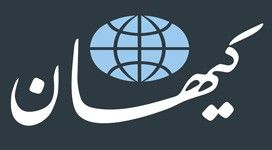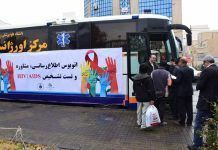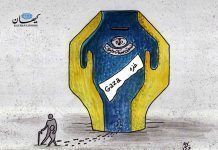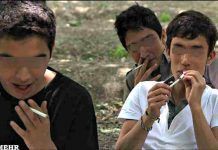December 30, 2016
By Ahmad Rafat
The deputy commander of the Islamic Revolutionary Guards Corps (IRGC), Brigadier-General Hossein Salami, has said that Iran’s primary objective for providing logistical, operational, technical, and tactical assistance to the pro-government forces in Syria, is to help that country rebuild its military and strengthen its territorial defence forces as well as enabling Iran to safeguard its interests in the region.
The Islamic Republic of Iran has been a staunch supporter of the Syrian President Bashar al-Assad since before the uprising in that country developed into a full scale civil war. The deployment of the IRGC’s Qods Force (IRGC-QF) to Aleppo is a clear indication of the important role which Tehran continues to play in the Syrian conflict. IRGC has also organized and funded a number of Shia militia groups hailing from Iraq, Lebanon, Afghanistan, Pakistan, Yemen, and even India, all of which are currently fighting in Syria.
Hojjat al-Islam Mehdi Ta’eb, the head of the Ammar Strategic Base – tasked with waging a so-called “soft war” against the opponents of the regime – believes that protecting Syria is even more important than defending Khuzestan province that borders Iraq and the Persian Gulf. Ta’eb argues, “If the enemy were to simultaneously attack Syria and Khuzestan, our main duty would be to defend Syria, because if we lose that country we would not be able to protect Tehran either.”
Syrian opposition groups have identified 39 organizations that receive financial and military support from IRGC’s Imam Hossein Headquarters, led by Brigadier-General Hossein Hamedani until his death in October 2015 in Aleppo. Hamedani has been the most senior IRGC officer to have been killed in Syria to date. After Hamedani’s death, Gholamhossein Gheybparvar, a high ranking IRGC officer, briefly took command of the organization before moving on to head of the Basij forces. A new commander has yet to be appointed to lead the organization.

According to Colonel Mohammad Eskandari, IRGC is prepared to deploy 42 brigades,138 battalions, almost 130,000 troops to the theatre of war in Syria. The commander of the IRGC, Major-General Mohammad Ali Ja’fari, estimates that 200,000 Iranian and non-Iranian troops are currently fighting under the auspices of IRGC forces in Syria. This figure most likely includes pro-Assad militia fighters trained and armed by Iran. Various sources put the number of Iran-sponsored Shia militia troops fighting in Syria between 18,000 to 100,000.
Avi Dichter, chairman of Israel’s Foreign Affairs and Defence Committee at the Knesset, believes that there are currently 25,000 Qods troops in Syria. Some US sources, however, estimate that between 80,000 to 100,000 Shia militias are fighting alongside IRGC and Assad’s forces in Syria.
IRGC-QF is arguably the strongest and most effective unit fighting in Syria. It was founded during the Iran-Iraq war, and gained strength and notoriety first in Iraq and then in Syria. It is primarily responsible for extraterritorial military and clandestine operations. Recent photographs of Major-General Qasem Soleimani, commander of the Qods Forces, walking alongside the pro-Assad troops in Aleppo is a clear testimony to the prominent role IRGC-QF plays in the Syrian conflict. The high death rate among the mid-ranking IRGC officers in Syria contradicts the claim by Iran that the force has played only an advisory role to Assad’s regime.
Among other major forces fighting under the control of the IRGC is the Shia Islamist militant Hezbollah of Lebanon, headed by Hassan Nasrallah who has openly spoken about the paramilitary wing of the group, the Jihad Council’s involvement in the Syrian war. Some reports suggest that the group has around 10,000 fighters in Syria, and that it also coordinates the operations of Iraqi Shia paramilitary groups, Kata’eb Hezbollah Brigade and Asa’eb Ahl al-Haq (a.k.a Khaz’ali Network). Hezbollah is, in effect, IRGC’s arm all over the Middle East. It has created a number of similar cells in Yemen, Pakistan, Syria, Tunisia, Iraq and Palestine.
The Syrian Hezbollah deployed its militia fighters to the war shortly after the armed insurgency in 2011, but it wasn’t until 2014 when it officially announced its involvement in the conflict. It is estimated that 20,000 Syrian fighters are armed and trained by IRGC.
One of the main Shia groups present in Syria is the Badr Organization, previously known as the Badr Brigade, which came to prominence in 2013 fighting the Islamic State of Iraq and the Levant (ISIL) in Iraq.It was formed in Iran in 1980 as the military wing of the Supreme Council for Islamic Revolution in Iraq (SCIRI). Its founder, Ayatollah Mohammad Baqir al-Hakim, was a senior Iraqi Shia cleric who was assassinated in a bomb attack in Najaf. The organization is currently headed by Hadi Al-Ameri, the former Iraqi minister of transportation, who has close ties to commander Soleimani. The organization is based at Camp Ashraf that previously housed the exiled Mojahedin-e Khalq (MKO).
Some of the fiercest fighters in Syria are militias protecting holy shrines, including the Brigade of Abu al-Fadl al-Abbas (a.k.a. Al-Abbas Brigade), a Shia militant group named after the son of Imam Ali. The group was formed in the city of Najaf in late 2012 by Liwa Al-Youm al Mow’oud, affiliated with the militant cleric Muqtada al-Sadr, and Asa’eb Ahl al-Haq, founded by Qais al-Khazal. This organization is currently under the leadership of Abu Ajeeb.
Perhaps the group best known for its role in guarding the holy shrines in Syria is the Liwa Fatemiyoun (a.k.a. Fatemiyoun Division), an Afghan Shia militia founded by IRGC in 2014 in the city of Mashhad. It comprises mainly of fighters from Hazarajat region of Afghanistan. Although the group denies any direct involvement from Iran, it is nevertheless part of the Qods Force. The division was originally made up of Afghan migrants who were paid little over $700 a month and sent to Syria after receiving basic training. Nowadays, IRGC recruits fighters in Afghanistan. Afghan fighters are promised permanent resident status at the end of their tour of duty. However, none of the soldiers who have returned from the war have been granted indefinite leave to stay in Iran. According to some Kabul newspapers, over 300 Afghan fighters have been killed in Syria to date. The leader of the Afghan Shias, Grand Ayatollah Mohaqiq Kabuli, has issued a fatwa sanctioning the presence of Afghan fighters in Syria and their duty to protect holy sites. The first commander of the division was Alireza Tavassoli who was killed in March of 2015 in the Syrian port city of Latakia. Tavassoli’s successor, Morteza Ataei was also killed in September 2016 in Latakia.
Another Shia militia group protecting the holy sites is the Zeynab Brigade, comprising mostly of fighters from the Khyber Pakhtunkhwa province in northwestern region of Pakistan. The brigade was originally part of Fatemiyoun Division, tasked with defending the Sayyidah Zaynab Mosque (the shrine of Zaynab bint Ali, the granddaughter of Mohammad), but it has been fighting in Aleppo for the past six months. It is under the command of a Pakistani national nicknamed “Karbala,” who has reportedly been wounded multiple times but has returned to the front line each time, after convalescing at a hospital in Tehran.
There are a number of lesser known Iranian-backed militia groups currently fighting in Syria, including Kata’eb Hezbollah Brigades led by Rahman Aljazayeri, Zulfikar Brigade, commanded by Fazel Sobhi, Saraya al – Khorasani with Sayyed Ali Yasirias as its secretary-general, Kata’eb Imam Ali led by Ali Mousavi until his death in March 2016, Sayyed al-Shuhada, under the command of Abu’ala Alwalaee, and Harakat Hezbollah al-Nujaba (movement of the Party of God’s nobles) under the command of Sheikh Akram al-Kaabi. The former commander of al-Nujaba, Abu Isa Eqlimi, and an IRGC officer Jihad Moghniyeh were killed in Quneitra, in south western Syria, allegedly by Israeli forces.









